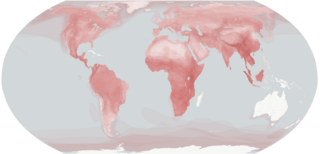
Carnivora is an order of placental mammals specialized primarily in eating flesh, whose members are formally referred to as carnivorans. The order Carnivora is the sixth largest order of mammals, comprising at least 279 species on every major landmass and in a variety of habitats, ranging from the cold polar regions of Earth to the hyper-arid region of the Sahara Desert and the open seas. Carnivorans exhibit a wide array of body plans, varying greatly in size and shape.

Canidae is a biological family of dog-like carnivorans, colloquially referred to as dogs, and constitutes a clade. A member of this family is also called a canid. The family includes three subfamilies: the Caninae, and the extinct Borophaginae and Hesperocyoninae. The Caninae are known as canines, and include domestic dogs, wolves, coyotes, foxes, jackals and other species.

The molars or molar teeth are large, flat teeth at the back of the mouth. They are more developed in mammals. They are used primarily to grind food during chewing. The name molar derives from Latin, molaris dens, meaning "millstone tooth", from mola, millstone and dens, tooth. Molars show a great deal of diversity in size and shape across the mammal groups. The third molar of humans is sometimes vestigial.

Canis is a genus of the Caninae which includes multiple extant species, such as wolves, dogs, coyotes, and golden jackals. Species of this genus are distinguished by their moderate to large size, their massive, well-developed skulls and dentition, long legs, and comparatively short ears and tails.

Amphicyonidae is an extinct family of terrestrial carnivorans belonging to the suborder Caniformia. They first appeared in North America in the middle Eocene, spread to Europe by the late Eocene, and further spread to Asia and Africa by the early Miocene. They had largely disappeared worldwide by the late Miocene, with the latest recorded species at the end of the Miocene in Africa. They were among the first carnivorans to evolve large body size. Amphicyonids are colloquially referred to as "bear-dogs".
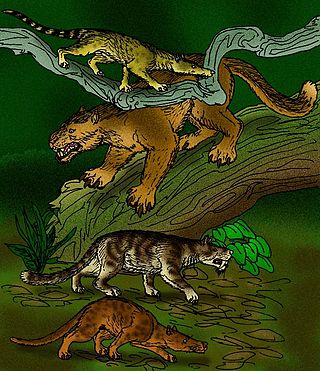
Creodonta is a former order of extinct carnivorous placental mammals that lived from the early Paleocene to the late Miocene epochs in North America, Europe, Asia and Africa. Originally thought to be a single group of animals ancestral to the modern Carnivora, this order is now usually considered a polyphyletic assemblage of two different groups, the oxyaenids and the hyaenodonts, not a natural group. Oxyaenids are first known from the Palaeocene of North America, while hyaenodonts hail from the Palaeocene of Africa.

Mesonychia is an extinct taxon of small- to large-sized carnivorous ungulates related to artiodactyls. Mesonychians first appeared in the early Paleocene, went into a sharp decline at the end of the Eocene, and died out entirely when the last genus, Mongolestes, became extinct in the early Oligocene. In Asia, the record of their history suggests they grew gradually larger and more predatory over time, then shifted to scavenging and bone-crushing lifestyles before the group became extinct.

Sparassodonta is an extinct order of carnivorous metatherian mammals native to South America, related to modern marsupials. They were once considered to be true marsupials, but are now thought to be a separate side branch that split before the last common ancestor of all modern marsupials.
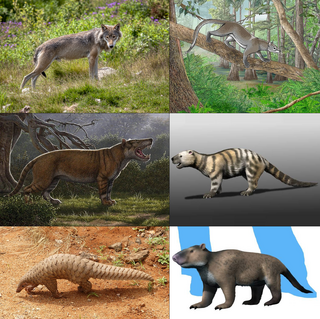
Ferae is a mirorder of placental mammals in grandorder Ferungulata, that groups together clades Pan-Carnivora and Pholidotamorpha.

Carnivoramorpha is a clade of placental mammals of clade Pan-Carnivora from mirorder Ferae, that includes the modern order Carnivora and its extinct stem-relatives.

Ankalagon saurognathus is an extinct carnivorous mammal of the family Mesonychidae, endemic to North America during the Paleocene epoch, existing for approximately 3.1 million years.

Ambondro mahabo is a mammal from the Middle Jurassic (Bathonian) Isalo III Formation of Madagascar. The only described species of the genus Ambondro, it is known from a fragmentary lower jaw with three teeth, interpreted as the last premolar and the first two molars. The premolar consists of a central cusp with one or two smaller cusps and a cingulum (shelf) on the inner, or lingual, side of the tooth. The molars also have such a lingual cingulum. They consist of two groups of cusps: a trigonid of three cusps at the front and a talonid with a main cusp, a smaller cusp, and a crest at the back. Features of the talonid suggest that Ambondro had tribosphenic molars, the basic arrangement of molar features also present in marsupial and placental mammals. It is the oldest known mammal with putatively tribosphenic teeth; at the time of its discovery it antedated the second oldest example by about 25 million years.

Triisodon is a genus of extinct mesonychian mammal that existed during the Early Paleocene of New Mexico, North America, from about 63.5-62.0 Ma. The genus was named by Edward Drinker Cope in 1881 as a member of the Acreodi, a now invalid taxon that encompassed creodonts, mesonychians and certain arctocyonians. Cope described the type specimen of T. quivirensis as "about the size of a wolf." A smaller species, T. crassicuspis, has also been identified from the same region. Since material from this genus is incomplete, the exact size of adults and whether they showed sexual dimorphism or regional variations in size is unknown.

Teeth are common to most vertebrates, but mammalian teeth are distinctive in having a variety of shapes and functions. This feature first arose among early therapsids during the Permian, and has continued to the present day. All therapsid groups with the exception of the mammals are now extinct, but each of these groups possessed different tooth patterns, which aids with the classification of fossils.

Gustafsonia is an extinct genus of carnivoran belonging to the family Amphicyonidae. The type species, Gustafsonia cognita, was described in 1986 by Eric Paul Gustafson, who originally interpreted it as a miacid and named it Miacis cognitus. It was subsequently considered to be the only species of the diverse genus Miacis that belonged to the crown-group Carnivora, within the Caniformia, and it was ultimately assigned to the family Amphicyonidae. The type specimen or holotype was discovered in Reeve's bonebed, western Texas, in the Chambers Tuff Formation in 1986. The University of Texas holds this specimen. It is the only confirmed fossil of this species.

Thylacosmilidae is an extinct family of metatherian predators, related to the modern marsupials, which lived in South America between the Miocene and Pliocene epochs. Like other South American mammalian predators that lived prior to the Great American Biotic Interchange, these animals belonged to the order Sparassodonta, which occupied the ecological niche of many eutherian mammals of the order Carnivora from other continents. The family's most notable feature are the elongated, laterally flattened fangs, which is a remarkable evolutionary convergence with other saber-toothed mammals like Barbourofelis and Smilodon.

Cheek teeth or postcanines comprise the molar and premolar teeth in mammals. Cheek teeth are multicuspidate. Mammals have multicuspidate molars and premolars situated between canines and molars whose shape and number varies considerably among particular groups. For example, many modern Carnivora possess carnassials, or secodont teeth. This scissor-like pairing of the last upper premolar and first lower molar is adapted for shearing meat. In contrast, the cheek teeth of deer and cattle are selenodont. Viewed from the side, these teeth have a series of triangular cusps or ridges, enabling the ruminants' sideways jaw motions to break down tough vegetable matter. Cheek teeth are sometimes separated from the incisors by a gap called a diastema.

Hyaenodonta is an extinct order of hypercarnivorous placental mammals of clade Pan-Carnivora from mirorder Ferae. Hyaenodonts were important mammalian predators that arose during the early Paleocene in Europe and persisted well into the late Miocene.
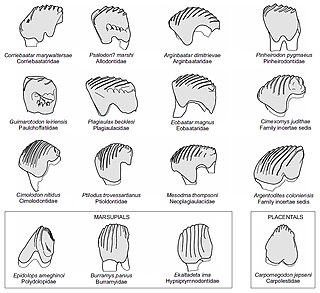
A plagiaulacoid is a type of blade-like, most often serrated, tooth present in various mammal groups, usually a premolar. Among modern species it is present chiefly on diprotodontian marsupials, which have both the upper and lower first premolars converted into serrated blades. However, various other extinct groups also possessed plagiaulacoids. These would be multituberculates, some "Plesiadapiformes" such as Carpolestes and various metatherians such as Epidolops and various early diprotodontians. In many of these only a lower premolar became converted into a blade, while the upper premolars showed less specialisation.
Peignecyon is an extinct genus of large carnivorans belonging to the family Amphicyonidae. It belongs to the subfamily Thaumastocyoninae, which is characterized by their adaptions towards hypercarnivory. Whereas most other thaumastocyonines are often only known from fragmentary remains and isolated teeth, Peignecyon is known from a variety of well-preserved remains. It contains a single species, P. felinoides from the Early Miocene of the Czech Republic.
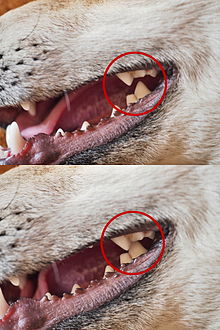
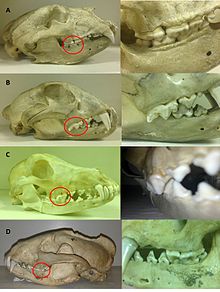


![A comparison of the size and shape of carnassial teeth in: [A] bear (Ursus), [B] leopard (Panthera), [C] dog (Canis), [D] badger (Meles), [E] otter (Lutra), [F] raccoon (Procyon), [G] mongoose (Herpestes), [H] weasel (Mustela). Photo taken at Imperial College London. Group Carnassial teeth.jpg](http://upload.wikimedia.org/wikipedia/commons/thumb/a/a2/Group_Carnassial_teeth.jpg/450px-Group_Carnassial_teeth.jpg)


















